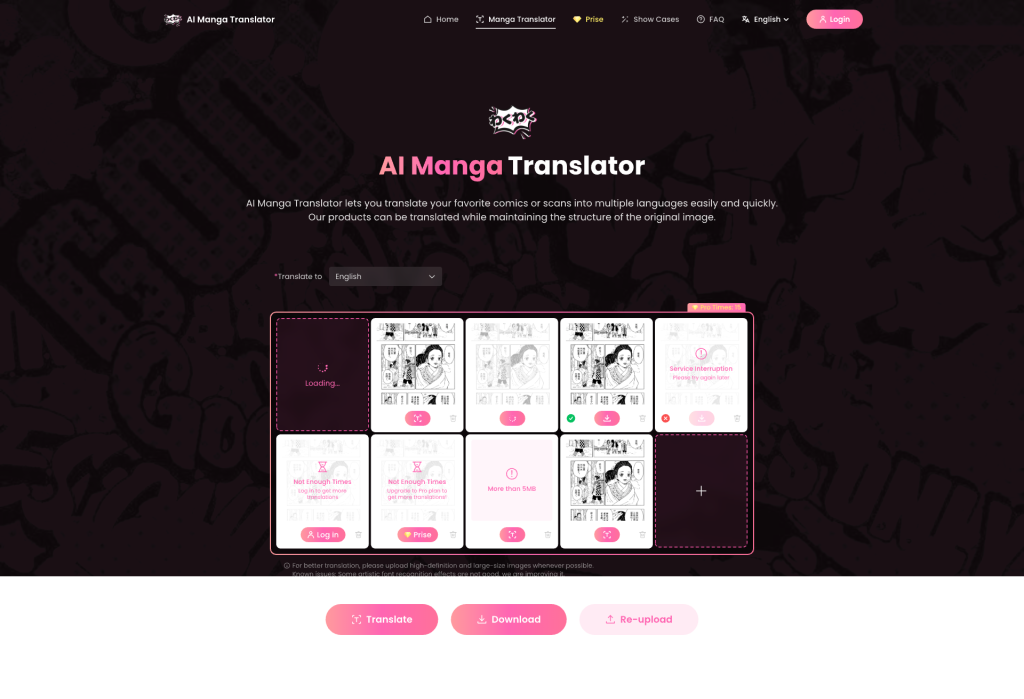If you’re a manga enthusiast or a budding translator, you know that manga translation can be a challenging yet rewarding task. Whether you’re translating manga for a fanbase or working on an official project, efficient manga translation requires the right tools, techniques, and a bit of know-how. In this article, we’ll guide you through the steps of manga translation and share tips that can help streamline the process.

Streamlining Manga Translation: The Right Tools Matter
One of the first steps in achieving high-quality manga translation is selecting the right tools. Manga translation isn’t just about translating the words; it’s about ensuring the story, emotions, and cultural nuances are preserved. This is where aimangatranslator.com comes into play. The tool helps eliminate some of the common issues that come with manual translations, speeding up the process while improving the accuracy of the translation.
When working on manga, it’s essential to use reliable software for text extraction and image editing. aimangatranslator.com helps with text translation while leaving the formatting and layout adjustments to be done later. By integrating AI-driven features, this tool allows translators to focus more on linguistic nuances and less on the technical work.
Breaking Down Manga Translation into Simple Steps
Step 1: Extracting Text from the Manga
The first thing you’ll need to do in manga translation is extract the text from the manga panels. You can either do this manually or use specialized software to assist with text recognition. If you’re using aimangatranslator.com, it automatically detects and extracts the text, saving time. This step is critical because the accuracy of the extraction will determine how well the translation can be adapted.
Step 2: Translating the Text
Once the text is extracted, it’s time to get into the manga translation itself. This involves converting the Japanese text into your target language while keeping the meaning, tone, and context intact. Unlike other types of translation, manga often includes cultural references, puns, and unique expressions that can be difficult to translate.
For example, Japanese honorifics like “-san,” “-chan,” and “-sama” don’t have direct equivalents in English. When working on manga translation, you’ll need to decide whether to leave the honorifics in place or replace them with their English counterparts, depending on the tone of the manga.
aimangatranslator.com helps simplify this process by providing translation suggestions, streamlining the workflow and ensuring that common phrases and terminology are accurately translated.
Step 3: Adapting Text to Fit the Artwork
In manga, the text has to fit within the artwork and speech bubbles. Unlike other types of translation, this part of manga translation requires careful attention to detail. Some languages will require more space than others, which could lead to text overflowing out of speech bubbles or becoming unreadable. This is where aimangatranslator.com can help—its layout optimization features adjust the text box sizes, ensuring that the translated text fits neatly into the manga artwork.
Step 4: Proofreading and Editing
Once you have your initial translation, it’s time to proofread and make necessary adjustments. Manga translation isn’t just about direct translation; it’s also about making sure the dialogue sounds natural and fits the characters’ voices. You may need to rework some sentences, adjust word choices, or tweak certain phrases to ensure they feel authentic.
To speed up the proofreading process, aimangatranslator.com provides grammar and syntax suggestions, helping translators spot mistakes before they become a problem. Whether you’re working on a romance manga or a shonen action series, this tool helps maintain the consistency and flow of your translation.
Why Accurate Manga Translation Is Key for Global Manga Fans
For manga fans around the world, an accurate and natural manga translation is crucial. Without it, the story can lose its original charm, and cultural references may go unnoticed. This is why it’s so important to ensure the translation process is both efficient and precise.
With manga becoming more globally popular, translators need to meet the demand for quick turnarounds while maintaining quality. This can be a tough balance, but with tools like aimangatranslator.com, you can improve your efficiency without sacrificing the quality of your work.
Enhancing Your Manga Translation with AI Technology
As we continue to embrace the future of digital tools, AI is making significant strides in the world of manga translation. aimangatranslator.com utilizes AI technology to help refine translations by suggesting more natural-sounding phrases and offering translations that stay true to the source material. AI-driven tools like these help take some of the pressure off human translators and allow them to focus on what truly matters—capturing the essence of the manga.
By leveraging AI in your manga translation process, you can work faster, avoid common translation mistakes, and deliver better-quality results to your readers. Whether you’re working on a popular manga series or a niche title, using the right technology ensures that your translation is both accurate and efficient.
Tips for Better Manga Translation
- Understand the Source Material: Always read through the manga before you start translating. Understanding the plot, characters, and cultural context will help you make more informed translation decisions.
- Be Mindful of Tone: Manga is known for its diverse range of tones, from dramatic to comedic. Make sure your translation matches the tone of the original text.
- Use Reputable Resources: Use reliable dictionaries, thesauruses, and translation tools like aimangatranslator.com to help with challenging words and phrases.
- Stay Consistent: For longer manga series, consistency in terms of character names, terminology, and speech patterns is key. Keep a glossary of terms for reference.
Related Tags:
- manga translation tools
- manga translator tips
- efficient manga translation
- manga translation software
- translate manga with AI